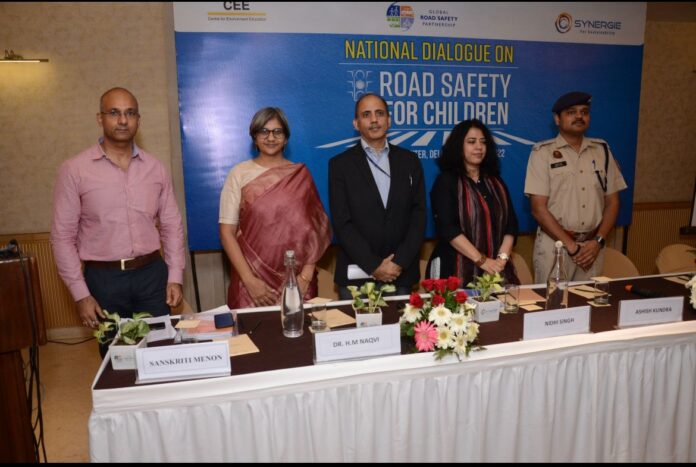New Delhi. September 15, 2022 : Synergie and Centre for Environment Education (CEE) today hosted a multi-stakeholder ‘National Dialogue on Road Safety for Children in India’ highlighting that over 25% of India’s population, or about 35.67 crore, are children who are vulnerable as road users. The dialogue was the first national level deliberation on road safety for children bringing together concerned officials from the ministries, experts, academia, corporates, businesses and civil society groups.
Mr. Saurabh Verma, Co- Founder, Synergie said “Our vision is to have zero fatalities amongst children due to road crashes. This is the guiding principle behind organizing National Dialogue on Road Safety for children. We want such platforms to act as catalysts to bring the issue of road safety for children at the forefront and nurture a conducive ecosystem to protect our children while commuting.”
Ms Sanskriti Menon, Program Director, Centre for Environment Education, highlighted that “While all have a shared concern about the safety of children as road users, there is a great need for shared responsibility and strengthening multi sectoral research, regulation, and innovation in implementation to achieve road safety for children”.
The delegates deliberated on the policy and implementation framework of the Motor Vehicles (Amendment) Act for children, the role of state governments, and the need for a conducive regulatory environment to ensure safety of children on roads. The panel discussed the risks associated with overspeeding and regulation of speed, effective implementation of school zones, improving safety near highways and the legislations on speed limits specified for the two wheelers, school transport vehicles, in school zones and other roads.
Shri Alap Patel, DCP Traffic, Delhi Police expressed that “children are vulnerable to road crashes while crossing the road or walking on footpaths. Vehicle drivers should inculcate safe speeding habits and to be on high alert when children travel to and from school”.
Several thousand schools are present on highways, which is a particularly hazardous situation. Officials from NHAI highlighted the target set by MoRTH for 50% reduction in fatalities on national highways and programs for the same.
Officials from BIS and medical professionals deliberated on the need for medical inputs and standards for child helmets for the age-group 9 months to 4 years as mandated in a new rule due to come into force in February 2023. While the use of child restraints in cars is already legislated, implementation needs to be strengthened.
International best practices from the Philippines on promoting the use of child restraints in cars and from Vietnam on promoting helmets illustrated the success of multisectoral approaches that combined educational efforts with legislation and enforcement. Case studies from Jorhat and Delhi illustrated the need for improvement of pedestrian facilities, speed control and traffic calming using participatory approaches for road safety improvements in school zones.
The delegates concluded that road safety for children is an area needing more research, attention to infrastructure design and strengthening enforcement, apart from awareness.
Ms Seema Jadhav, Deputy Vice President, ICICI Lombard shared how their flagship CSR initiative ‘ride to safety’ is inculcating responsibility for promoting helmet use among children as pillion riders.
Dr Chetan Ginigeri, a pediatrician specializing in trauma care spoke about the importance of preventing injuries, and the need for devising child road safety strategies that consider the specific physical, emotional, mental characteristics of children.
Shri Binay Pattanayak, senior education consultant, The World Bank, India suggested “Let us win the hearts of children by caring for them on roads and in society”.
Prof Bhargab Maitra, IIT Kharagpur and an expert on speed regulation highlighted the need for focused attention for creating safe road environments using scientific speed management interventions including road engineering, enforcement and education. “The safety of school vehicles is also a major concern and development of a standard operating procedure (SOP) for school vehicles is the need of the day”, he said.
Dr Manas Pratim Roy, Ministry of Health and Family Welfare: “Roads should be child friendly. Let’s ensure safer roads for the kids. The future citizens deserve it.”
Dr Shankar Vishwanath, Hon. Advisory Traffic Branch, Mumbai Police: A safe road is a child’s right.
Dr Mukti Advani, Principal Scientist, CRRI: Intervention is required from each of the stakeholders and more specifically with respect to speed limit of 20-25 km per hour for the school zones.
Ruchi Verma, Founder, HumanQind: Safe school zones are a unique opportunity to build safety, liveability and sustainability in communities with children getting an equal seat in the decision making process.

